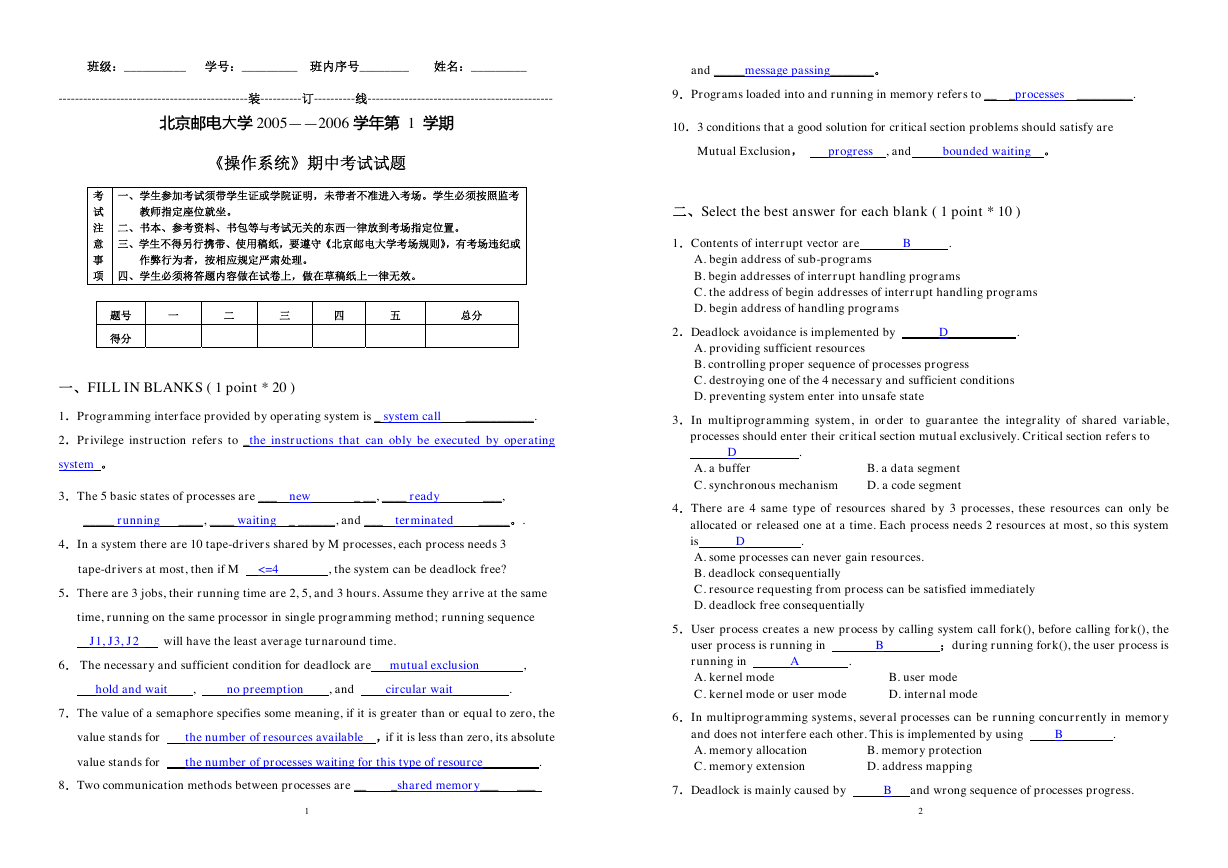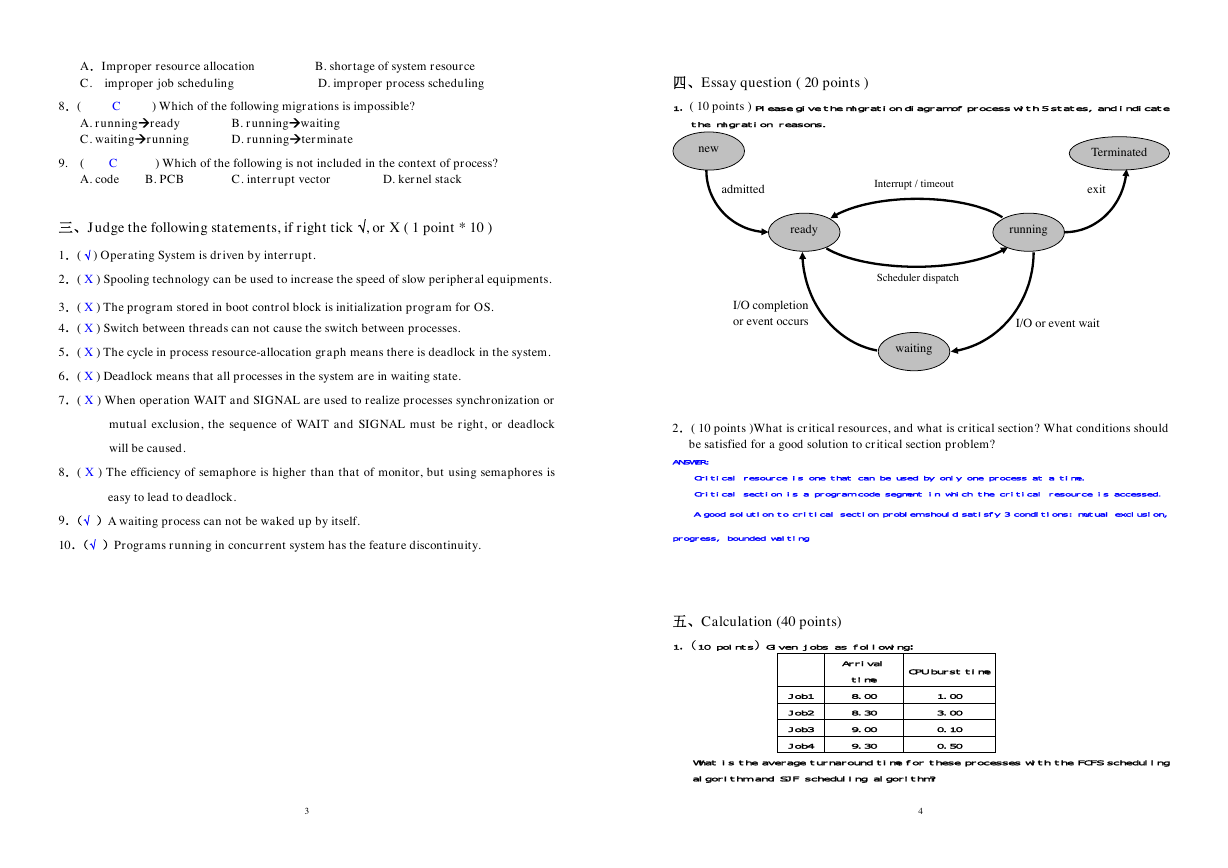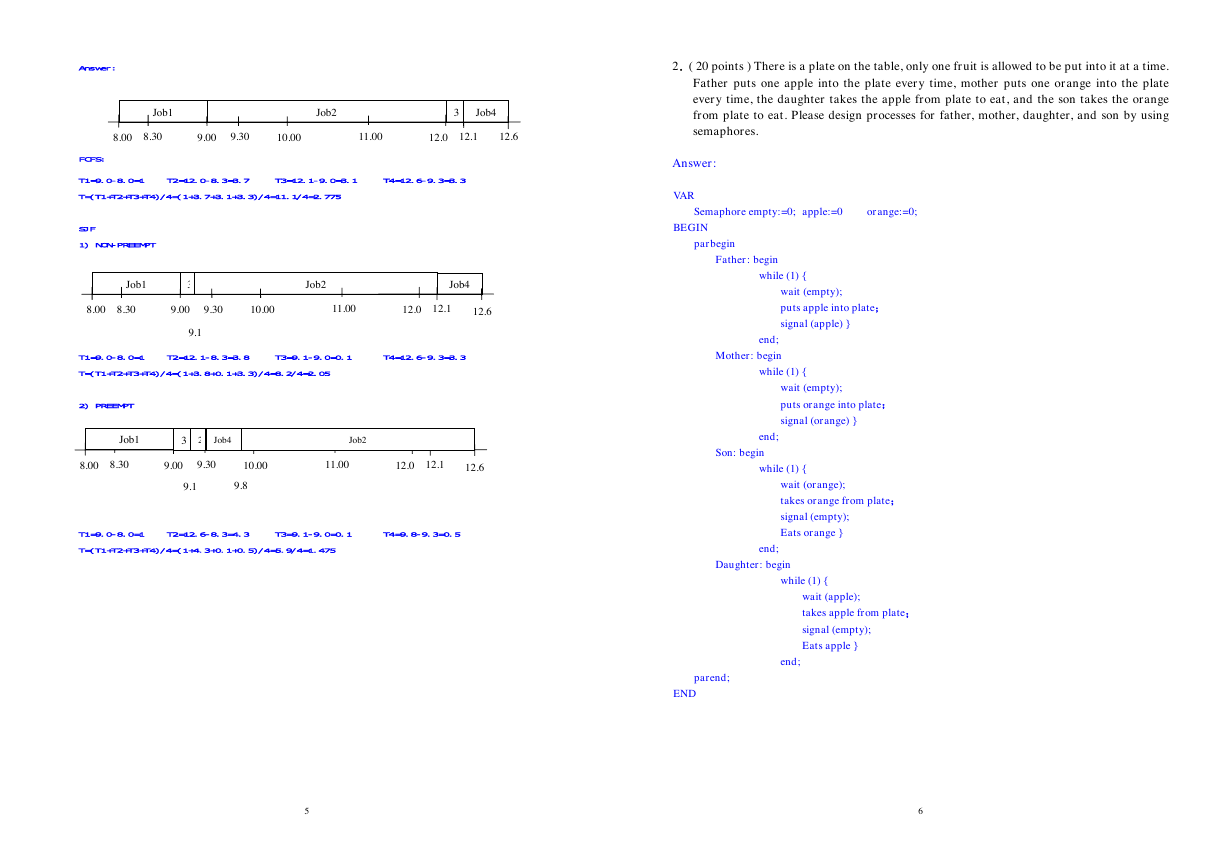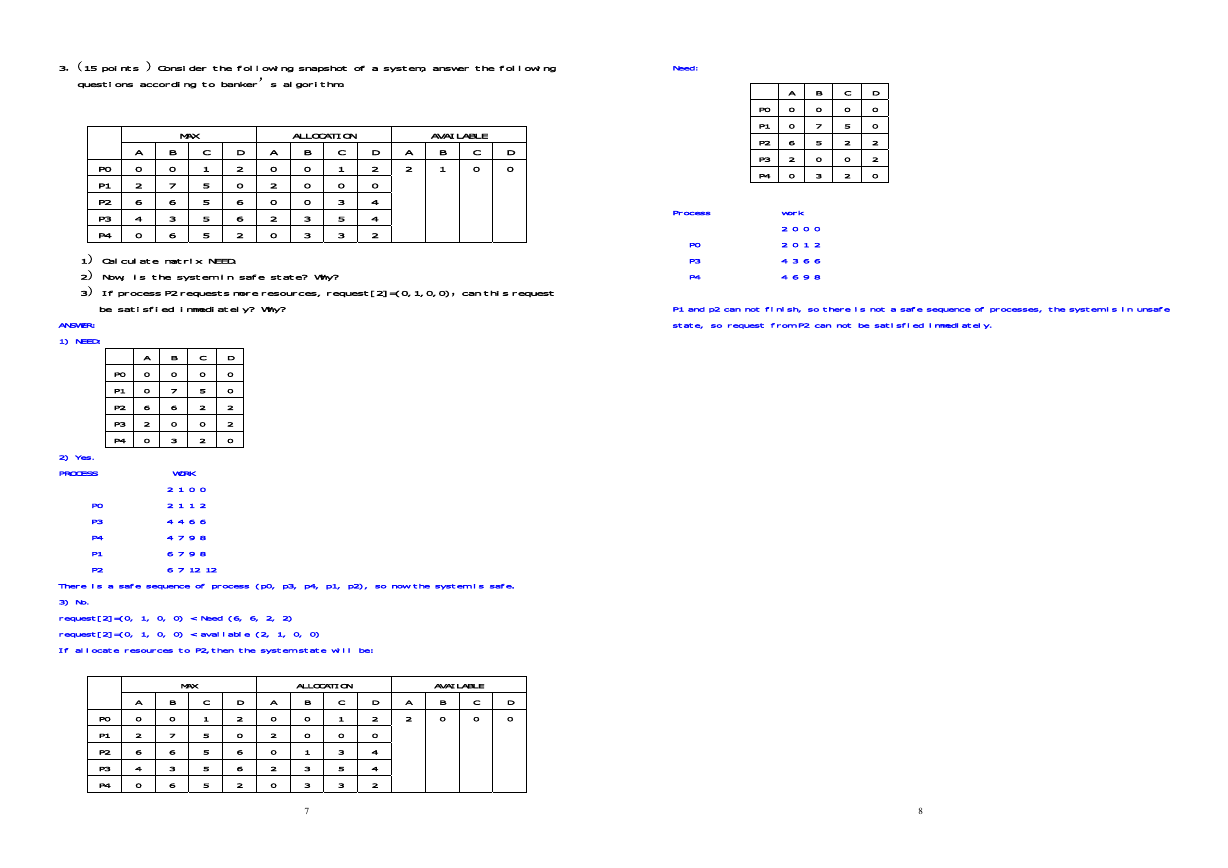班级:__________ 学号:_________ 班内序号________ 姓名:_________
----------------------------------------------装----------订----------线---------------------------------------------
北京邮电大学 2005——2006 学年第 1 学期
《操作系统》期中考试试题
考
试
注
意
事
项
一、学生参加考试须带学生证或学院证明,未带者不准进入考场。学生必须按照监考
教师指定座位就坐。
二、书本、参考资料、书包等与考试无关的东西一律放到考场指定位置。
三、学生不得另行携带、使用稿纸,要遵守《北京邮电大学考场规则》,有考场违纪或
作弊行为者,按相应规定严肃处理。
四、学生必须将答题内容做在试卷上,做在草稿纸上一律无效。
题号
得分
一
二
三
四
五
总分
一、FILL IN BLANKS ( 1 point * 20 )
1.Programming interface provided by operating system is _ system call ___________.
2.Privilege instruction refers to _the instructions that can obly be executed by operating
system 。
3.The 5 basic states of processes are ___ new _ __, ____ ready ___,
_____ running ____, ____ waiting _ ______, and ___ terminated _____。.
4.In a system there are 10 tape-drivers shared by M processes, each process needs 3
tape-drivers at most, then if M <=4 , the system can be deadlock free?
5.There are 3 jobs, their running time are 2, 5, and 3 hours. Assume they arrive at the same
time, running on the same processor in single programming method; running sequence
J1, J3, J2 will have the least average turnaround time.
6. The necessary and sufficient condition for deadlock are mutual exclusion ,
hold and wait , no preemption , and circular wait .
7.The value of a semaphore specifies some meaning, if it is greater than or equal to zero, the
value stands for the number of resources available ,if it is less than zero, its absolute
value stands for the number of processes waiting for this type of resource .
8.Two communication methods between processes are __ _shared memory___ ___
and _____message passing_______。
9.Programs loaded into and running in memory refers to __ _processes _________.
10.3 conditions that a good solution for critical section problems should satisfy are
Mutual Exclusion, progress , and bounded waiting 。
二、Select the best answer for each blank ( 1 point * 10 )
1.Contents of interrupt vector are B .
A. begin address of sub-programs
B. begin addresses of interrupt handling programs
C. the address of begin addresses of interrupt handling programs
D. begin address of handling programs
2.Deadlock avoidance is implemented by D .
A. providing sufficient resources
B. controlling proper sequence of processes progress
C. destroying one of the 4 necessary and sufficient conditions
D. preventing system enter into unsafe state
3.In multiprogramming system, in order to guarantee the integrality of shared variable,
processes should enter their critical section mutual exclusively. Critical section refers to
D .
A. a buffer
C. synchronous mechanism
B. a data segment
D. a code segment
4.There are 4 same type of resources shared by 3 processes, these resources can only be
allocated or released one at a time. Each process needs 2 resources at most, so this system
is D .
A. some processes can never gain resources.
B. deadlock consequentially
C. resource requesting from process can be satisfied immediately
D. deadlock free consequentially
5.User process creates a new process by calling system call fork(), before calling fork(), the
user process is running in B ;during running fork(), the user process is
running in A .
A. kernel mode
C. kernel mode or user mode
B. user mode
D. internal mode
6.In multiprogramming systems, several processes can be running concurrently in memory
and does not interfere each other. This is implemented by using B .
A. memory allocation
C. memory extension
7.Deadlock is mainly caused by B and wrong sequence of processes progress.
B. memory protection
D. address mapping
1
2
�
A.Improper resource allocation
C. improper job scheduling
B. shortage of system resource
D. improper process scheduling
8.( C ) Which of the following migrations is impossible?
A. runningready
C. waitingrunning
B. runningwaiting
D. runningterminate
9. ( C ) Which of the following is not included in the context of process?
C. interrupt vector
D. kernel stack
A. code
B. PCB
三、Judge the following statements, if right tick √, or X ( 1 point * 10 )
1.( √ ) Operating System is driven by interrupt.
2.( X ) Spooling technology can be used to increase the speed of slow peripheral equipments.
3.( X ) The program stored in boot control block is initialization program for OS.
4.( X ) Switch between threads can not cause the switch between processes.
5.( X ) The cycle in process resource-allocation graph means there is deadlock in the system.
6.( X ) Deadlock means that all processes in the system are in waiting state.
7.( X ) When operation WAIT and SIGNAL are used to realize processes synchronization or
mutual exclusion, the sequence of WAIT and SIGNAL must be right, or deadlock
will be caused.
8.( X ) The efficiency of semaphore is higher than that of monitor, but using semaphores is
easy to lead to deadlock.
9.(√ )A waiting process can not be waked up by itself.
10.(√ )Programs running in concurrent system has the feature discontinuity.
四、Essay question ( 20 points )
1.( 10 points ) Please give the migration diagram of process with 5 states, and indicate
the migration reasons.
new
admitted
Interrupt / timeout
Terminated
exit
ready
running
I/O completion
or event occurs
Scheduler dispatch
waiting
I/O or event wait
2.( 10 points )What is critical resources, and what is critical section? What conditions should
be satisfied for a good solution to critical section problem?
ANSWER:
Critical resource is one that can be used by only one process at a time.
Critical section is a program code segment in which the critical resource is accessed.
A good solution to critical section problem should satisfy 3 conditions: mutual exclusion,
progress, bounded waiting
五、Calculation (40 points)
1.(10 points)Given jobs as following:
Job1
Job2
Job3
Job4
Arrival
time
8.00
8.30
9.00
9.30
CPU burst time
1.00
3.00
0.10
0.50
3
4
What is the average turnaround time for these processes with the FCFS scheduling
algorithm and SJF scheduling algorithm?
�
Answer:
Job1
Job2
3
Job4
8.00
8.30
9.00
9.30
10.00
11.00
12.0
12.1
12.6
FCFS:
T3=12.1-9.0=3.1
T2=12.1-8.3=3.8
T3=9.1-9.0=0.1
Job2
11.00
8.00
Job1
3
9.00
9.30
10.00
T2=12.0-8.3=3.7
T1=9.0-8.0=1
T=(T1+T2+T3+T4)/4=(1+3.7+3.1+3.3)/4=11.1/4=2.775
SJF
1) NON-PREEMPT
8.30
2) PREEMPT
T1=9.0-8.0=1
T=(T1+T2+T3+T4)/4=(1+3.8+0.1+3.3)/4=8.2/4=2.05
2) PREEMPT
8.00 8.30
T1=9.0-8.0=1
T=(T1+T2+T3+T4)/4=(1+4.3+0.1+0.5)/4=5.9/4=1.475
T2=12.6-8.3=4.3
2
Job4
9.00
9.30
10.00
Job1
9.1
9.8
9.1
3
Job2
11.00
T3=9.1-9.0=0.1
T4=12.6-9.3=3.3
Job4
12.0
12.1
12.6
T4=12.6-9.3=3.3
12.0
12.1
12.6
T4=9.8-9.3=0.5
2.( 20 points ) There is a plate on the table, only one fruit is allowed to be put into it at a time.
Father puts one apple into the plate every time, mother puts one orange into the plate
every time, the daughter takes the apple from plate to eat, and the son takes the orange
from plate to eat. Please design processes for father, mother, daughter, and son by using
semaphores.
Answer:
VAR
BEGIN
Semaphore empty:=0; apple:=0
orange:=0;
parbegin
Father: begin
while (1) {
wait (empty);
puts apple into plate;
signal (apple) }
end;
Mother: begin
while (1) {
wait (empty);
puts orange into plate;
signal (orange) }
end;
Son: begin
while (1) {
wait (orange);
takes orange from plate;
signal (empty);
Eats orange }
end;
Daughter: begin
while (1) {
wait (apple);
takes apple from plate;
signal (empty);
Eats apple }
end;
parend;
END
5
6
�
3.(15 points )Consider the following snapshot of a system, answer the following
questions according to banker’s algorithm.
MAX
ALLOCATION
AVAILABLE
A
0
2
6
4
0
B
0
7
6
3
6
C
1
5
5
5
5
D
2
0
6
6
2
A
0
2
0
2
0
B
0
0
0
3
3
C
1
0
3
5
3
D
2
0
4
4
2
P0
P1
P2
P3
P4
A
2
B
1
C
0
D
0
1) Calculate matrix NEED.
2) Now, is the system in safe state? Why?
3) If process P2 requests more resources, request[2]=(0,1,0,0),can this request
be satisfied immediately? Why?
ANSWER:
1) NEED:
P0
P1
P2
P3
P4
A
0
0
6
2
0
B
0
7
6
0
3
C
0
5
2
0
2
D
0
0
2
2
0
P4
P3
P2
P0
P1
2
3
0
0
2
5
0
0
C
5
7
0
0
2
2
2
6
0
0
D
B
A
0
0
Need:
Process work
2 0 0 0
P0 2 0 1 2
P3 4 3 6 6
P4 4 6 9 8
P1 and p2 can not finish, so there is not a safe sequence of processes, the system is in unsafe
state, so request from P2 can not be satisfied immediately.
WORK
2 1 0 0
2 1 1 2
4 4 6 6
4 7 9 8
6 7 9 8
6 7 12 12
2) Yes.
PROCESS
P0
P3
P4
P1
P2
There is a safe sequence of process (p0, p3, p4, p1, p2), so now the system is safe.
3) No.
request[2]=(0, 1, 0, 0) < Need (6, 6, 2, 2)
request[2]=(0, 1, 0, 0) < available (2, 1, 0, 0)
If allocate resources to P2,then the system state will be:
ALLOCATION
AVAILABLE
MAX
P0
P1
P2
P3
0
7
6
3
A
B
C
D
A
B
C
A
B
D
0
1
2
0
0
1
2
5
4
4
D
2
6
4
5
5
6
6
0
2
1
3
3
5
C
0
0
2
0
0
0
2
0
0
P4
0
6
5
2
0
3
3
2
7
8
�








 2023年江西萍乡中考道德与法治真题及答案.doc
2023年江西萍乡中考道德与法治真题及答案.doc 2012年重庆南川中考生物真题及答案.doc
2012年重庆南川中考生物真题及答案.doc 2013年江西师范大学地理学综合及文艺理论基础考研真题.doc
2013年江西师范大学地理学综合及文艺理论基础考研真题.doc 2020年四川甘孜小升初语文真题及答案I卷.doc
2020年四川甘孜小升初语文真题及答案I卷.doc 2020年注册岩土工程师专业基础考试真题及答案.doc
2020年注册岩土工程师专业基础考试真题及答案.doc 2023-2024学年福建省厦门市九年级上学期数学月考试题及答案.doc
2023-2024学年福建省厦门市九年级上学期数学月考试题及答案.doc 2021-2022学年辽宁省沈阳市大东区九年级上学期语文期末试题及答案.doc
2021-2022学年辽宁省沈阳市大东区九年级上学期语文期末试题及答案.doc 2022-2023学年北京东城区初三第一学期物理期末试卷及答案.doc
2022-2023学年北京东城区初三第一学期物理期末试卷及答案.doc 2018上半年江西教师资格初中地理学科知识与教学能力真题及答案.doc
2018上半年江西教师资格初中地理学科知识与教学能力真题及答案.doc 2012年河北国家公务员申论考试真题及答案-省级.doc
2012年河北国家公务员申论考试真题及答案-省级.doc 2020-2021学年江苏省扬州市江都区邵樊片九年级上学期数学第一次质量检测试题及答案.doc
2020-2021学年江苏省扬州市江都区邵樊片九年级上学期数学第一次质量检测试题及答案.doc 2022下半年黑龙江教师资格证中学综合素质真题及答案.doc
2022下半年黑龙江教师资格证中学综合素质真题及答案.doc